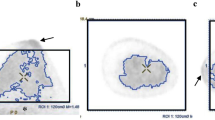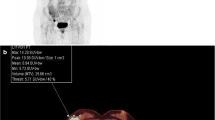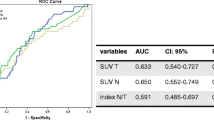Abstract
Objective
This study was conducted to assess the effect of breast density, age, and menopausal status on the 2-deoxy-2-[F-18]fluoro-D-glucose (FDG) uptake in normal breast tissue by quantitative standardized uptake values (SUV).
Methods
A total of 96 patients (premenopausal 54; postmenopausal 42) with histologically proven unilateral breast cancer who underwent FDG-positron emission tomography (PET) scans for staging were included in this study. The median age was 52±11 years (range 32–79 years). Fifty-nine patients had grade III or IV mammographic density (dense breast), whereas 37 patients had grade I or II breast density (nondense) according to the ACR Lexicon criteria. In the present study, we analyzed maximum and average SUVs for contralateral normal breast.
Results
Maximum and average SUVs for normal dense breasts were 1.02±0.30 and 0.84±0.27, respectively. Similar values for the nondense breasts were 0.66±0.24 and 0.53±0.23, respectively. Both maximum and average SUVs of dense breasts were significantly higher than those of nondense breasts (p<0.001). There was no significant difference in SUVs of nipple in patients with dense and nondense breasts. There was no significant effect of age and menopausal status on SUVs of normal breast. However, there were trends of negative relationship, i.e., decreasing SUVs with increasing age.
Conclusion
There was a significant difference in SUVs between the dense and nondense normal breast. However, the maximum SUVs in the dense breasts were well below the threshold of 2.5, a widely used cutoff value for malignancy. Menopausal status and age do not significantly affect the uptake of FDG.







Similar content being viewed by others
References
Jemal A, Murray T, Ward E, Samuels A, Tiwari RC, Ghafoor A, et al. (2005) Cancer statistics, 2005. CA Cancer J Clin 55:10–30
Surveillance, Epidemiology, and End Results (SEER) Program www.seer.cancer.gov) SEER Statistics Database: Incidence—SEE (1973–2000), National Cancer Institute, DCCPS, Surveillance Research Program, Cancer Statistics Branch
Rosenberg RD, Hunt WC, Williamson MR, Gilliland FD, Wiest PW, Kelsey CA, et al. (1998) Effects of age, breast density, ethnicity, and estrogen replacement therapy on screening mammographic sensitivity and cancer stage at diagnosis: review of 183,134 screening mammograms in Albuquerque, New Mexico. Radiology 209:511–518
Baines CJ, Miller AB, Wall C, McFarlane DV, Simor IS, Jong R, et al. (1986) Sensitivity and specificity of first screen mammography in the Canadian National Breast Screening Study: a preliminary report from five centers. Radiology 160:295–298
Fletcher SW, Black W, Harris R, Rimer BK, Shapiro S (1993) Report of the International Workshop on Screening for Breast Cancer. J Natl Cancer Inst 85:1644–1656
Tabar L, Fagerberg G, Chen HH, Duffy SW, Smart CR, Gad A, et al. (1995) Efficacy of breast cancer screening by age. New results from the Swedish Two-County Trial. Cancer 75:2507–2517
Frisell J, Klund G, Hellstrom L (1991) Randomized study of mammography screening: preliminary report on mortality in the Stockholm trial. Breast Cancer Res Treat 18:49–56
Kolb TM, Lichy J, Newhouse JH (2002) Comparison of the performance of screening mammography, physical examination, and breast US and evaluation of factors that influence them: an analysis of 27,825 patient evaluations. Radiology 225:165–175
Salvatore M, Del Vecchio S (1998) Dynamic imaging: scintimammography. Eur J Radiol 27 Suppl 2:S259–264
Mandelson MT, Oestreicher N, Porter PL, White D, Finder CA, Taplin SH, et al. (2000) Breast density as a predictor of mammographic detection: comparison of interval- and screen-detected cancers. J Natl Cancer Inst 92:1081–1087
Lehman CD, White E, Peacock S, Drucker MJ, Urban N (1999) Effect of age and breast density on screening mammograms with false-positive findings. AJR 173:1651–1655
Nieweg OE, Kim EE, Wong WH (1993) Positron emission tomography with fluorine-18-deoxyglucose in the detection and staging of breast cancer. Cancer 71:3920–3925
Hoh CK, Schiepers C (1999) 18-FDG imaging in breast cancer. Semin Nucl Med 29:49–56
Adler LP, Crowe JP, al-Kaisi NK, Sunshine JL (1993) Evaluation of breast masses and axillary lymph nodes with [F-18]2-deoxy-2-fluoro- d-glucose PET. Radiology 187:743–750
Palmedo H, Bender H, Grunwald F, Mallmann P, Zamora P, Krebs D, et al. (1997) Comparison of fluorine-18 fluorodeoxyglucose positron emission tomography and technetium-99m methoxyisobutylisonitrile scintimammography in the detection of breast tumours. Eur J Nucl Med 24:1138–1145
Avril N, Dose J, Janicke F, Bense S, Ziegler S, Laubenbacher C, et al. (1996) Metabolic characterization of breast tumors with positron emission tomography using F-18 fluorodeoxyglucose. J Clin Oncol 14:1848–1857
Alavi A, Kung JW, Zhuang H (2004) Implications of PET based molecular imaging on the current and future practice of medicine. Semin Nucl Med 34:56–69
Vranjesevic D, Schiepers C, Silverman DH, Quon A, Villalpando J, Dahlbom M, et al. (2003) Relationship between 18F-FDG uptake and breast density in women with normal breast tissue. J Nucl Med 44:1238–1242
Kumar R, Schnall MD, Alavi A (2004) 18F-FDG uptake and breast density in women with normal breast tissue. J Nucl Med 45:1423–1424
Pisano ED, Yaffe MJ (2005) Digital mammography. Radiology 234:353–362
Kumar R, Alavi A (2004) Fluorodeoxyglucose-PET in the management of breast cancer. Radiol Clin North Am 42:1113–1122
Ciatto S, Zappa MA (1993) A prospective study of the value of mammographic patterns as indicators of breast cancer risk in a screening experience. Eur J Radiol 17:122–125
Flook D, Gilhome RW, Harman J, Gravelle IH, Webster DJ (1987) Changes in Wolfe mammographic patterns with aging. Br J Radiol 60:455–456
Wolfe JN (1976) Breast parenchymal patterns and their changes with age. Radiology 121:545–552
Kerlikowske K, Grady D, Barclay J, Sickles EA, Ernster V (1996) Effect of age, breast density, and family history on the sensitivity of first screening mammography. JAMA 276:33–38
Zasadny KR, Wahl RL (1993) Standardised uptake values of normal tissues at PET with 2-[fluorine-18]-fluoro-2-deoxy-d-glucose: variations with body weight and a method for correction. Radiology 189:847–850
Acknowledgments
This work was supported by Public Health Services Research Grant M01-RR00040 from NIH. Rakesh Kumar, M.D., was financially supported by UICC (International Union Against Cancer) Geneva, Switzerland under ACSBI fellowship.
Author information
Authors and Affiliations
Corresponding author
Rights and permissions
About this article
Cite this article
Kumar, R., Chauhan, A., Zhuang, H. et al. Standardized Uptake Values of Normal Breast Tissue with 2-Deoxy-2-[F-18]Fluoro-d-glucose Positron Emission Tomography: Variations with Age, Breast Density, and Menopausal Status. Mol Imaging Biol 8, 355–362 (2006). https://doi.org/10.1007/s11307-006-0060-5
Published:
Issue Date:
DOI: https://doi.org/10.1007/s11307-006-0060-5




